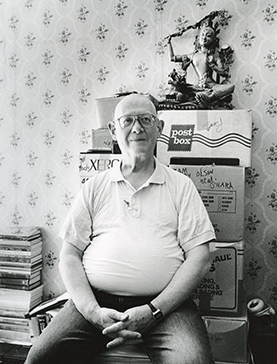
IRIS login | Reed College home Volume 95, No. 2: June 2016
Loosen Up. Festoon!
This is the third time that I’ve written you a letter, this one sparked by having just now read John Sheehy’s nicely written and sober review of the new biography of Philip Whalen ’51 by David Schneider ’73, Crowded by Beauty. I would like to offer a more enthusiastic perspective.
The first of my three letters was written in 1972 when I was living at the Tassajara Zen monastery not long after graduating from Reed in “philosophy & religion.” For identification purposes, should one of my surviving comrades read this, I was “Ricky Levine” at Reed. Then known as “Rick” for four decades, now “Rickety.” (Recall the riddle of the sphinx?)

Philip Whalen ’51, San Francisco, 1988
Photo by Rob Lee
On a cold gray rainy mountain day in the winter of ’72 I received the Reed alumni news at Tassajara and was reflecting with my dharma brothers Phil Whalen and Patrick McMahon ’69 at the news of illustrious attainments. Everyone was enjoying great success in business, enrollment in prestigious universities, advanced degrees, impressive titles. With Phil’s encouragement I sent you our news: “Rick Levine and Patrick McMahon are sorting rocks as to small, middling, and large for an esoteric fringe group in the California wilderness.”
Despite suffering a lifelong “poetical indisposition,” Phil had an air of bemused dignity and quiet authority. In the “tea area” there was a peg-board where everyone kept their coffee/tea mug. A strip of masking tape served as label to identify the owner. Mine said “Rick,” Patrick’s said “Pat.” Phil’s said “Philip G. Whalen, B.A.” (I for one read an allusion to Joyce’s Ulysses here). Phil lived, as we all do, in many worlds. Literature was prominent among them, and resonant echoes of language, spoken and literary, resounded in his daily life and society. As Schneider chronicles, Phil was awarded the BA in literature from Reed College in 1951, not without considerable travail.
My second letter was composed some few years later. It was a protest against the disestablishment of calligraphy at Reed as a central, accredited, and emblematic course offering. I, like Phil before me, was a student (disciple even) and advisee of Prof. Lloyd J. Reynolds [English and art, 1929-69], from whom I learned to read books, one after another, and several at the same time. I learned the history of the alphabet, the Perennial Philosophy, and how to cut & operate a pen using a reed and a pen-knife. (I had the good fortune to study under Father Robert Palladino as well.) A friend showed to the poet Robert Creeley a letter that I had written her. He glanced and commented, so she told me, “oh yeah, Reed-writing”. In more ways than one.
And now this, my third letter. Crowded By Beauty, David Schneider’s biography of Philip, is brilliantly written, and a lifeline he’s tossed to save whoever’s around to catch it—a rope braided with Phil’s personal and poetry histories; the history of “the Beats,” both East Coast and especially their West Coast iterations; with Friendship and friendships; with the Reed Poets’ lineage and their Pacific Northwest background; with Professor Lloyd Reynolds’s influence and the Portland revival of calligraphy & handwriting; with Buddhism; with Buddhism in America; with the authoritative self-Secret Oral Teachings of Buddhism; with how to read a poem (and the latter not just for slow learners and the dim-witted, but a primer for guys just like me, for me!).
David has the deep, credible expertise to illuminate all these strands, not least because he attended Reed, knows the ground where Phil’s life as a poet began, and is uniquely situated to have produced this stunning book. He is an accomplished calligrapher himself, in both Roman alphabets and Siddham script, an acharya (teacher) in the Shambhala lineage of Tibetan Buddhism, and a shuso-level priest (“Head Monk”) in Zen Buddhism. He is the author of a previous outstanding biography of the flamboyant cross-dressing Zen adept named Issan Dorsey, titled Street Zen, in which Issan’s wild early life is lovingly depicted as well as his founding of a prominent, still-flourishing San Francisco AIDS hospice called Maitri, where Issan later died of the disease. Most of all David was a Boswell to Phil’s Samuel Johnson—he had intimate personal contact with Phil over decades. In the spirit of disclosure, I’ll add that Phil was my mentor, dharma friend, patient, role model. And David Schneider, also my friend, my kalyanamitra (Buddhist practice ally), has re-animated his creative living presence.
Finally, since I’m going on and on, I want to convey my good will to the Reed community. It’s no accident that Patrick (“Patroclus”) McMahon, distinguished Evergreen State College professor Sam Schrager ’70, and I have been meeting regularly for 10 years by monthly telephone conference to discuss our reading. Our salon has gone through Proust, some of Kafka, and now Joyce. These discussions have roots in the shared vocabulary of our undergraduate humanities conferences.
Editor's Note: Thanks, Rick, for this epic epistle. Father Palladino died this spring, but helped revive calligraphy at Reed through the Cooley Gallery’s Calligraphy Initiative.

LATEST COMMENTS
steve-jobs-1976 I knew Steve Jobs when he was on the second floor of Quincy. (Fall...
Utnapishtim - 2 weeks ago
Prof. Mason Drukman [political science 1964–70] This is gold, pure gold. God bless, Prof. Drukman.
puredog - 1 month ago
virginia-davis-1965 Such a good friend & compatriot in the day of Satyricon...
czarchasm - 4 months ago
John Peara Baba 1990 John died of a broken heart from losing his mom and then his...
kodachrome - 7 months ago
Carol Sawyer 1962 Who wrote this obit? I'm writing something about Carol Sawyer...
MsLaurie Pepper - 8 months ago
William W. Wissman MAT 1969 ...and THREE sisters. Sabra, the oldest, Mary, the middle, and...
riclf - 10 months ago